technical data SKODA FABIA 2010 2.G / 5J Workshop Manual
[x] Cancel search | Manufacturer: SKODA, Model Year: 2010, Model line: FABIA, Model: SKODA FABIA 2010 2.G / 5JPages: 244, PDF Size: 29.53 MB
Page 102 of 244
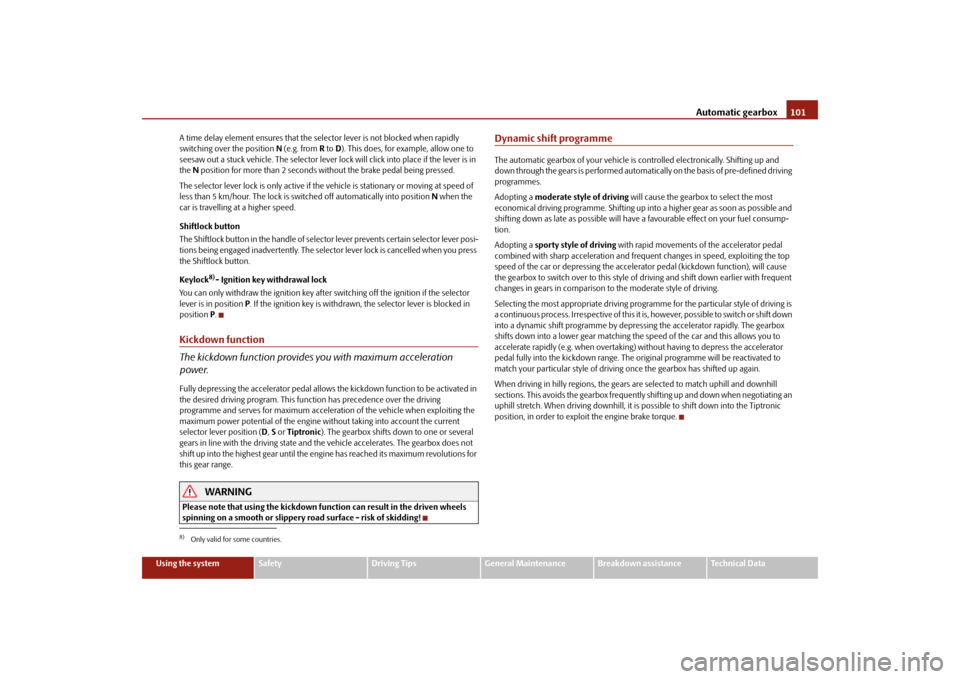
Automatic gearbox
101
Using the system
Safety
Driving Tips
General Maintenance
Breakdown assistance
Technical Data
A time delay element ensures that the selector lever is not blocked when rapidly switching over the position
N (e.g. from
R to D). This does, for example, allow one to
seesaw out a stuck vehicle. The selector lever lo
ck will click into place if the lever is in
the
N position for more than 2 seconds without the brake pedal being pressed.
The selector lever lock is only active if the
vehicle is stationary or
moving at speed of
less than 5 km/hour. The lock is swit
ched off automatically into position
N when the
car is travelling at a higher speed. Shiftlock button The Shiftlock button in the hand
le of selector lever prevents certain selector lever posi-
tions being engaged inadvertently. The selector lever lock is cancelled when you press the Shiftlock button. Keylock
8)- Ignition key withdrawal lock
You can only withdraw the ignition key after switching off the ignition if the selector lever is in position
P. If the ignition key is withdrawn, the selector lever is blocked in
position
P.
Kickdown function The kickdown function provides you with maximum acceleration power.Fully depressing the accelerator pedal allows
the kickdown function to be activated in
the desired driving program. This function has precedence over the driving programme and serves for maximum acceleration of the vehicle when exploiting the maximum power potential of the engine wi
thout taking into account the current
selector lever position (
D, S or Tiptronic
). The gearbox shifts down to one or several
gears in line with the driving state and the vehicle accelerates. The gearbox does not shift up into the highest gear until the en
gine has reached its maximum revolutions for
this gear range.
WARNING
Please note that using the kickdown function can result in the driven wheels spinning on a smooth or slippery road surface - risk of skidding!
Dynamic shift programmeThe automatic gearbox of your vehicle is
controlled electronically. Shifting up and
down through the gears is performed automatically on the basis of pre-defined driving programmes. Adopting a
moderate style of driving
will cause the gearbox to select the most
economical driving programme. Shifting up into a higher gear as soon as possible and shifting down as late as po
ssible will have a favourable effect on your fuel consump-
tion. Adopting a
sporty style of driving
with rapid movements of the accelerator pedal
combined with sharp acceleration and freque
nt changes in speed, exploiting the top
speed of the car or depressing the accele
rator pedal (kickdown function), will cause
the gearbox to switch over to this style of driving and shift down earlier with frequent changes in gears in comparison to the moderate style of driving. Selecting the most appropriate driving programme for the particular style of driving is a continuous process. Irrespective of this it is, however, possible to switch or shift down into a dynamic shift programme by depressi
ng the accelerator rapidly. The gearbox
shifts down into a lower gear matching the speed of the car and this allows you to accelerate rapidly (e.g. when overtaking)
without having to depress the accelerator
pedal fully into the kickdown range. The or
iginal programme will be reactivated to
match your particular styl
e of driving once the gearbox has shifted up again.
When driving in hilly regions, the gears are selected to match uphill and downhill sections. This avoids the gearbox frequently
shifting up and down when negotiating an
uphill stretch. When driving downhill, it is
possible to shift do
wn into the Tiptronic
position, in order to exploit the engine brake torque.
8)Only valid for some countries.
s3j8.a.book Page 101 Tuesday, April 20, 2010 1:10 PM
Page 104 of 244
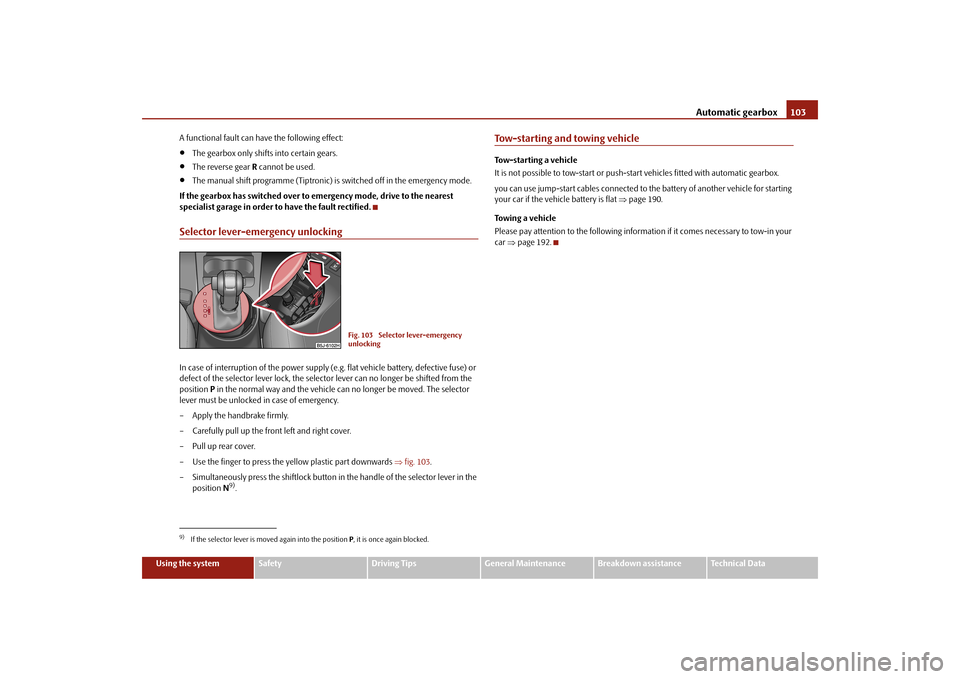
Automatic gearbox
103
Using the system
Safety
Driving Tips
General Maintenance
Breakdown assistance
Technical Data
A functional fault can have the following effect:
The gearbox only shifts into certain gears.
The reverse gear
R cannot be used.
The manual shift programme (Tiptronic) is switched off in the emergency mode.
If the gearbox has switch
ed over to emergency mode, drive to the nearest
specialist garage in order to have the fault rectified.Selector lever-emergency unlockingIn case of interruption of the power supply (e
.g. flat vehicle battery, defective fuse) or
defect of the selector lever lock, the select
or lever can no longer be shifted from the
position
P in the normal way and the vehicle ca
n no longer be moved. The selector
lever must be unlocked in case of emergency. – Apply the handbrake firmly.– Carefully pull up the front left and right cover.– Pull up rear cover.– Use the finger to press the yellow plastic part downwards
fig. 103
.
– Simultaneously press the shiftlock button in
the handle of the selector lever in the
position
N9).
Tow-starting and towing vehicle Tow-starting a vehicle It is not possible to tow-start or push-sta
rt vehicles fitted wi
th automatic gearbox.
you can use jump-start
cables connected to the battery of another vehicle for starting
your car if the vehicle battery is flat
page 190.
Towing a vehicle Please pay attention to the following information if it comes necessary to tow-in your car
page 192.
9)If the selector lever is moved again into the position
P, it is once again blocked.Fig. 103 Selector lever-emergency unlocking
s3j8.a.book Page 103 Tuesday, April 20, 2010 1:10 PM
Page 106 of 244
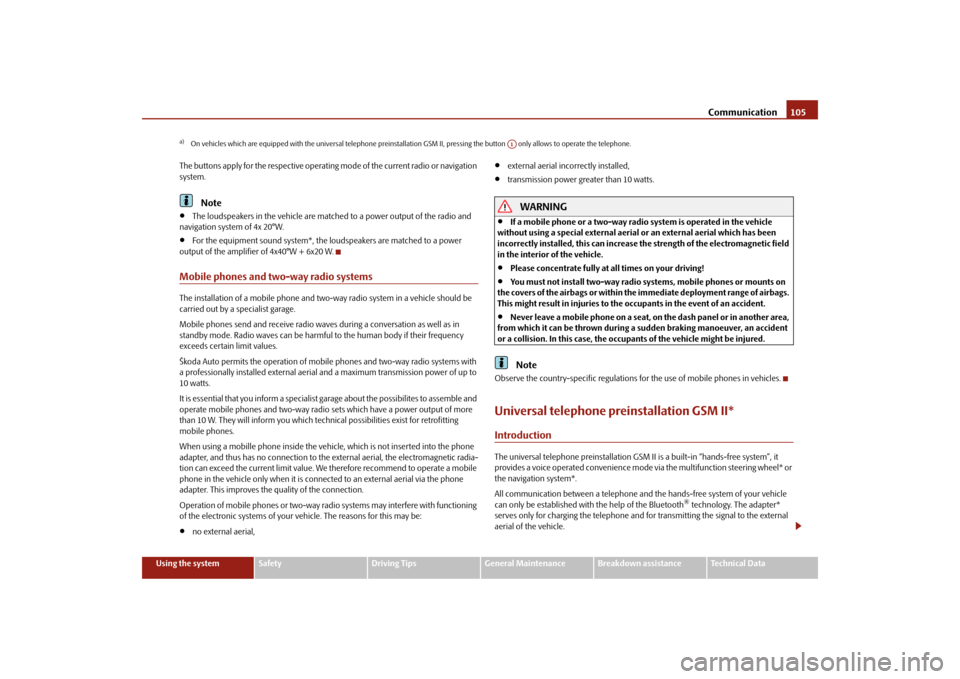
Communication
105
Using the system
Safety
Driving Tips
General Maintenance
Breakdown assistance
Technical Data
The buttons apply for the respective operating mode of the current radio or navigation system.
Note
The loudspeakers in the vehicle are matched to a power output of the radio and
navigation system of 4x 20°W.
For the equipment sound system*, the loudspeakers are matched to a power
output of the amplifier of 4x40°W + 6x20 W.Mobile phones and tw
o-way radio systems
The installation of a mobile phone and two-way radio system in a vehicle should be carried out by a specialist garage. Mobile phones send and receive radio wave
s during a conversation as well as in
standby mode. Radio waves can be harmful
to the human body if their frequency
exceeds certain limit values. Škoda Auto permits the operation of mobile
phones and two-way radio systems with
a professionally installed external aerial and a maximum transmission power of up to 10 watts. It is essential that you inform a specialist garage about the possibilites to assemble and operate mobile phones and two-way radio sets which have a power output of more than 10 W. They will inform you which technical possibilities exist for retrofitting mobile phones. When using a mobille phone inside the vehicl
e, which is not inserted into the phone
adapter, and thus has no connection to the
external aerial, the electromagnetic radia-
tion can exceed the current limit value. We therefore recommend to operate a mobile phone in the vehicle only when it is conne
cted to an external aerial via the phone
adapter. This improves the quality of the connection. Operation of mobile phones or two-way ra
dio systems may interfere with functioning
of the electronic systems of your vehicle. The reasons for this may be:
no external aerial,
external aerial incorrectly installed,
transmission power gr
eater than 10 watts.
WARNING
If a mobile phone or a two-way radio
system is operated in the vehicle
without using a special external aerial
or an external aerial which has been
incorrectly installed, this can increase
the strength of the electromagnetic field
in the interior of the vehicle.
Please concentrate fully at
all times on your driving!
You must not install two-way radio systems, mobile phones or mounts on
the covers of the airbags or within the immediate deployment range of airbags. This might result in injuries to the
occupants in the event of an accident.
Never leave a mobile phone on a seat, on
the dash panel or in another area,
from which it can be thrown during a sudden braking manoeuver, an accident or a collision. In this case, the occupants of the vehicle might be injured.
Note
Observe the country-specific regulations for the use of mobile phones in vehicles.Universal telephone preinstallation GSM II*IntroductionThe universal telephone preinstallation GSM
II is a built-in “hands-free system”, it
provides a voice operated convenience mode via the multifunction steering wheel* or the navigation system*. All communication between a telephone and
the hands-free system of your vehicle
can only be established with the help of the Bluetooth
® technology. The adapter*
serves only for charging the telephone and fo
r transmitting the signal to the external
aerial of the vehicle.
a)On vehicles which are equipped with the universal telephone prei
nstallation GSM II, pressing the button only allows to operate
the telephone.
A1
s3j8.a.book Page 105 Tuesday, April 20, 2010 1:10 PM
Page 108 of 244
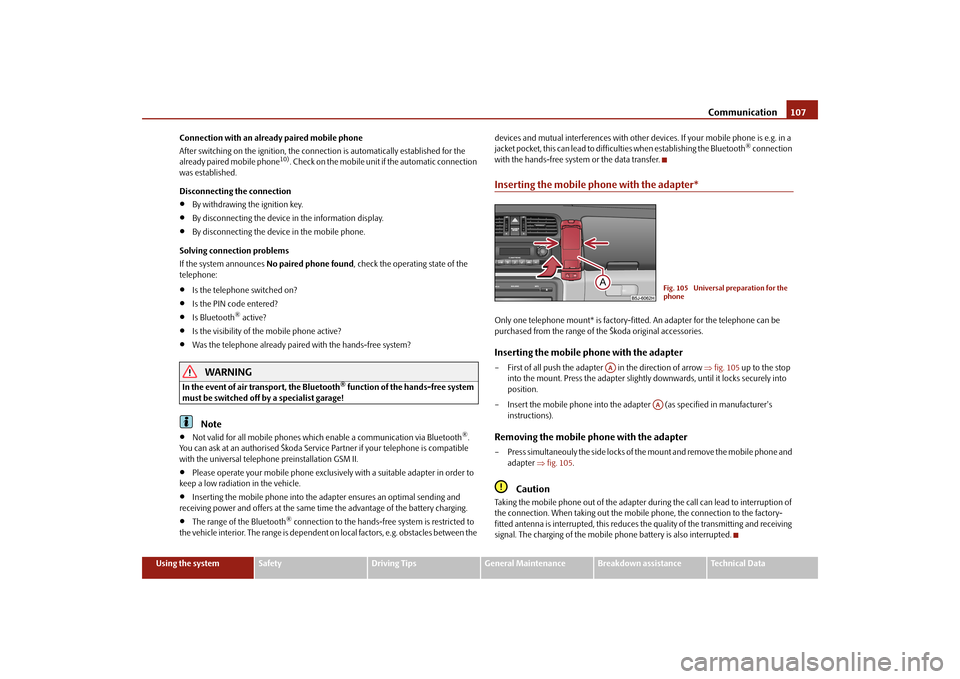
Communication
107
Using the system
Safety
Driving Tips
General Maintenance
Breakdown assistance
Technical Data
Connection with an already paired mobile phone After switching on the ignition, the connect
ion is automatically established for the
already paired mobile phone
10). Check on the mobile unit if the automatic connection
was established. Disconnecting the connection
By withdrawing the ignition key.
By disconnecting the device in the information display.
By disconnecting the device in the mobile phone.
Solving connection problems If the system announces
No paired phone found
, check the operating state of the
telephone:
Is the telephone switched on?
Is the PIN code entered?
Is Bluetooth
® active?
Is the visibility of the mobile phone active?
Was the telephone already paired with the hands-free system?
WARNING
In the event of air transport, the Bluetooth
® function of the hands-free system
must be switched off by a specialist garage!
Note
Not valid for all mobile phones which enable a communication via Bluetooth
®.
You can ask at an authorised Škoda Service Partner if your telephone is compatible with the universal telephone preinstallation GSM II.
Please operate your mobile phone exclusiv
ely with a suitable adapter in order to
keep a low radiation in the vehicle.
Inserting the mobile phone into the adapter ensures an optimal sending and
receiving power and offers at the same ti
me the advantage of the battery charging.
The range of the Bluetooth
® connection to the hands-free system is restricted to
the vehicle interior. The range is dependent on local factors, e.g. obstacles between the
devices and mutual interferences with other de
vices. If your mobile phone is e.g. in a
jacket pocket, this can lead to diffic
ulties when establishing the Bluetooth
® connection
with the hands-free system or the data transfer.Inserting the mobile phone with the adapter*Only one telephone mount* is factory-fitted. An adapter for the telephone can be purchased from the range of the Škoda original accessories.Inserting the mobile phone with the adapter– First of all push the adapter in the direction of arrow
fig. 105
up to the stop
into the mount. Press the adapter slightly downwards, until it locks securely into position.
– Insert the mobile phone into the adap
ter (as specified in manufacturer's
instructions).
Removing the mobile phone with the adapter– Press simultaneouly the side locks of the mount and remove the mobile phone and
adapter
fig. 105
.
Caution
Taking the mobile phone out of the adapter du
ring the call can lead to interruption of
the connection. When taking out the mobi
le phone, the connection to the factory-
fitted antenna is interrupted, this reduces the quality of the transmitting and receiving signal. The charging of the mobile
phone battery is also interrupted.
Fig. 105 Universal preparation for the phone
AA
AA
s3j8.a.book Page 107 Tuesday, April 20, 2010 1:10 PM
Page 110 of 244

Communication
109
Using the system
Safety
Driving Tips
General Maintenance
Breakdown assistance
Technical Data
The buttons operate the functions for the operating mode of the current telephone.Operate the telephone via the information display*The display of texts in the menu
Phone
is possible in the following languages:
Czech, English, German, French, Italia
n, Spanish, Russian and Portuguese.
In the menu
Phone
you can select the following menu points:
Phone book
Dial number
Call register
Voice mailbox
Bluetooth
Settings
Back
Phone book In the menu point
Phone book
is the list of the loaded contacts from the telephone
memory and the SIM card of the mobile phone. In the phone phonebook there are 2 500 free memory locations available. Dial number In the menu point
Dial number
, you can write any telephone number. Select in
sequence the desired digits with the aid of
the handwheel and confirm it by pressing
the handwheel. You can select the numbers
0 - 9
, the symbols
+, , # and the func-
tions
Delete, Call, Cancel
.
Call register In the menu point
Call register
, you can select the following menu points:
Missed calls
Received calls
Last calls
Voice mailbox In the menu
Voice mailbox
, it is possible to set the number of the voice mailbox and
then dial the number. Bluetooth In the menu
Bluetooth
you can select the following menu points:
User
- the overview of the stored users
New user
- Search for new telephones which are in the reception range
Visibility
- Switching on the visibility of
the telephone unit for other devices
Media player
Active device
Paired devices
Search
Phone name
- the possibility to change the name of the telephone unit (pre-set
SKODA UHV) Settings In the menu
Settings
you can select the following menu points:
Phone book
Update
List
Surname
First name
Ring tone
Back Return in the basic menu of the telephone.
Note
The readout of the menu
Phone
and the voice control are no
t possible in the Chinese
language.
s3j8.a.book Page 109 Tuesday, April 20, 2010 1:10 PM
Page 112 of 244
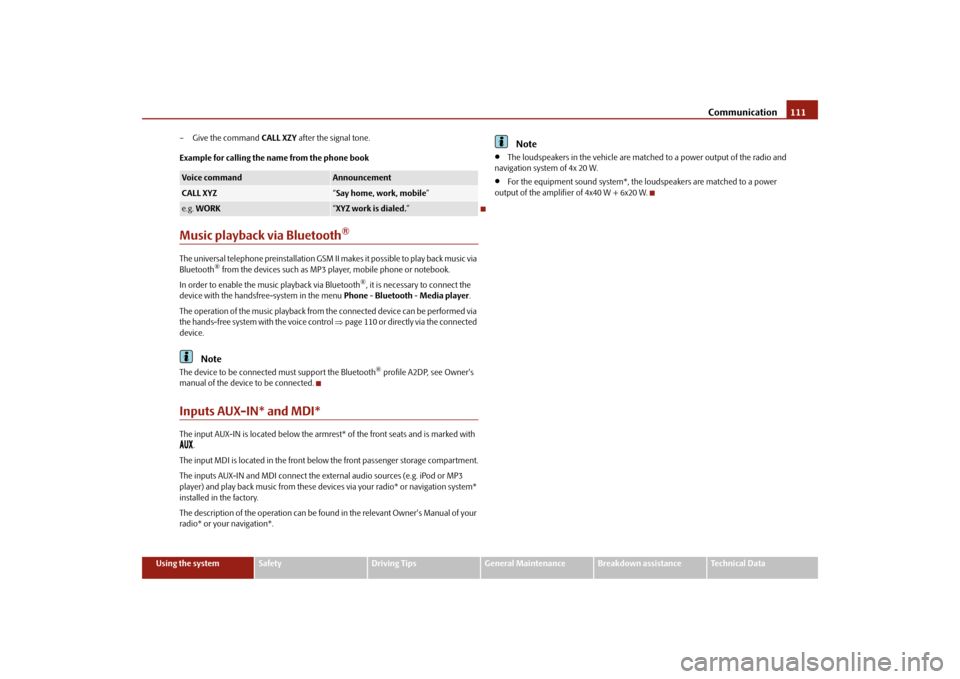
Communication
111
Using the system
Safety
Driving Tips
General Maintenance
Breakdown assistance
Technical Data
– Give the command
CALL XZY
after the signal tone.
Example for calling the name from the phone bookMusic playback via Bluetooth
®
The universal telephone preinstallation GSM II
makes it possible to play back music via
Bluetooth
® from the devices such as MP3 player, mobile phone or notebook.
In order to enable the music playback via Bluetooth
®, it is necessary to connect the
device with the handsfree-system in the menu
Phone
- Bluetooth
- Media player
.
The operation of the music pl
ayback from the connected de
vice can be performed via
the hands-free system with the voice control
page 110 or directly via the connected
device.
Note
The device to be connected must support the Bluetooth
® profile A2DP, see Owner's
manual of the device to be connected.Inputs AUX-IN* and MDI*The input AUX-IN is located below the armrest* of the front seats and is marked with
.
The input MDI is located in the front belo
w the front passenger storage compartment.
The inputs AUX-IN and MDI connect the ex
ternal audio sources (e.g. iPod or MP3
player) and play back music fr
om these devices via your radio* or navigation system*
installed in the factory. The description of the operation can be found
in the relevant Owner's Manual of your
radio* or your navigation*.
Note
The loudspeakers in the vehicle are matched to a power output of the radio and
navigation system of 4x 20 W.
For the equipment sound system*, the
loudspeakers are matched to a power
output of the amplifier of 4x40 W + 6x20 W.
Voice command
Announcement
CALL XYZ
“ Say home, work, mobile
”
e.g.
WORK
“XYZ work is dialed.
”
s3j8.a.book Page 111 Tuesday, April 20, 2010 1:10 PM
Page 114 of 244
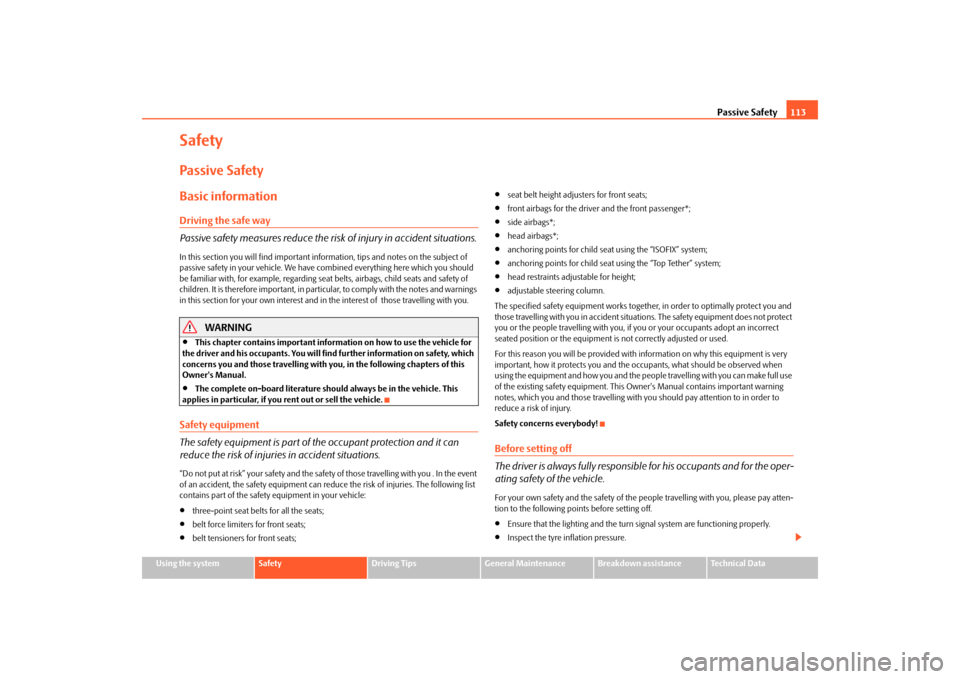
Passive Safety
113
Using the system
Safety
Driving Tips
General Maintenance
Breakdown assistance
Technical Data
SafetyPassive SafetyBasic informationDriving the safe way Passive safety measures reduce the risk
of injury in accident situations.
In this section you will find important info
rmation, tips and notes on the subject of
passive safety in your vehicle. We have
combined everything here which you should
be familiar with, for example, regarding seat
belts, airbags, child seats and safety of
children. It is therefore important, in partic
ular, to comply with the notes and warnings
in this section for your own interest and in the interest of those travelling with you.
WARNING
This chapter contains important information on how to use the vehicle for
the driver and his occupants. You will find further information on safety, which concerns you and those travelling with you, in the following chapters of this Owner's Manual.
The complete on-board literature should always be in the vehicle. This
applies in particular, if you rent out or sell the vehicle.Safety equipment The safety equipment is part of the occupant protection and it can reduce the risk of injuries in accident situations.“Do not put at risk” your safety and the safety of those travelling with you . In the event of an accident, the safety equipment can redu
ce the risk of injuries. The following list
contains part of the safety
equipment in your vehicle:
three-point seat belts for all the seats;
belt force limiters for front seats;
belt tensioners for front seats;
seat belt height adjusters for front seats;
front airbags for the driver and the front passenger*;
side airbags*;
head airbags*;
anchoring points for child seat using the “ISOFIX” system;
anchoring points for child seat using the “Top Tether” system;
head restraints adjustable for height;
adjustable steering column.
The specified safety equipment works togeth
er, in order to optimally protect you and
those travelling with you in accident situat
ions. The safety equipment does not protect
you or the people travelling with you, if
you or your occupants adopt an incorrect
seated position or the equipment is
not correctly adjusted or used.
For this reason you will be provided with information on why this equipment is very important, how it protects you and the occupants, what should be observed when using the equipment and how you and the peop
le travelling with you can make full use
of the existing safety equipment. This
Owner's Manual contains important warning
notes, which you and those travelling with
you should pay attention to in order to
reduce a risk of injury. Safety concerns everybody!Before setting off The driver is always fully responsibl
e for his occupants and for the oper-
ating safety of the vehicle.For your own safety and the safety of the pe
ople travelling with you, please pay atten-
tion to the following points before setting off.
Ensure that the lighting and the turn signal system are functioning properly.
Inspect the tyre inflation pressure.
s3j8.a.book Page 113 Tuesday, April 20, 2010 1:10 PM
Page 116 of 244
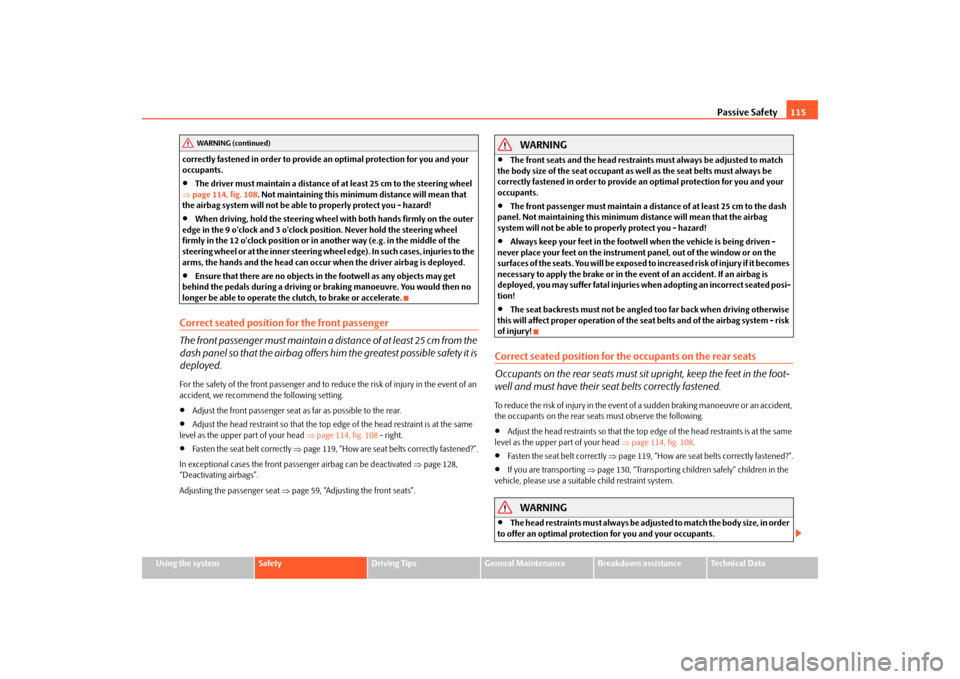
Passive Safety
115
Using the system
Safety
Driving Tips
General Maintenance
Breakdown assistance
Technical Data
correctly fastened in order to provide an optimal protection for you and your occupants.
The driver must maintain a distance of
at least 25 cm to
the steering wheel
page 114, fig. 108
. Not maintaining this minimum distance will mean that
the airbag system will not be able to properly protect you - hazard!
When driving, hold the st
eering wheel with both hands firmly on the outer
edge in the 9 o'clock and 3 o'clock po
sition. Never hold
the steering wheel
firmly in the 12 o'clock position or in another way (e.g. in the middle of the steering wheel or at the inner steering wheel
edge). In such cases, injuries to the
arms, the hands and the head can occur
when the driver airbag is deployed.
Ensure that there are no objects in
the footwell as an
y objects may get
behind the pedals during a driving or
braking manoeuvre. You would then no
longer be able to operate the
clutch, to brake or accelerate.
Correct seated position for the front passenger The f ro n t p as s en ger mus t mai n tai n a d i s tan ce of a t l ea s t 25 c m f rom th e dash panel so that the airbag offers him the greatest possible safety it is deployed.For the safety of the front pass
enger and to reduce the risk of injury in the event of an
accident, we recommend
the following setting.
Adjust the front passenger seat as
far as possible to the rear.
Adjust the head restraint so that the top ed
ge of the head restraint is at the same
level as the upper pa
rt of your head
page 114, fig. 108
- right.
Fasten the seat belt correctly
page 119, “How are seat belts correctly fastened?”.
In exceptional cases the front pass
enger airbag can be deactivated
page 128,
“Deactivating airbags”. Adjusting the passenger seat
page 59, “Adjusting the front seats”.
WARNING
The front seats and the head restraints must always be adjusted to match
the body size of the seat occupant as well as the seat belts must always be correctly fastened in order to provide an optimal protection for you and your occupants.
The front passenger must maintain a distance of at least 25 cm to the dash
panel. Not maintaining this minimum distance will mean that the airbag system will not be able to properly protect you - hazard!
Always keep your feet in the footwel
l when the vehicle is being driven -
never place your feet on the instrument panel, out of the window or on the surfaces of the seats. You will be exposed to increased risk of injury if it becomes necessary to apply the brake or in the ev
ent of an accident. If an airbag is
deployed, you may suffer fatal injuries wh
en adopting an incorrect seated posi-
tion!
The seat backrests must not be angled
too far back when driving otherwise
this will affect proper operation of the se
at belts and of the airbag system - risk
of injury!Correct seated position for the occupants on the rear seats Occupants on the rear seats must sit upright, keep the feet in the foot- well and must have their se
at belts correctly fastened.
To reduce the risk of injury in the event of
a sudden braking manoeuvre or an accident,
the occupants on the rear seats must observe the following.
Adjust the head restraints so that the top edge of the head restraints is at the same
level as the upper part of your head
page 114, fig. 108
.
Fasten the seat belt correctly
page 119, “How are seat belts correctly fastened?”.
If you are transporting
page 130, “Transporting children safely” children in the
vehicle, please use a suitable child restraint system.
WARNING
The head restraints must always be adjusted to match the body size, in order
to offer an optimal protection for you and your occupants.
WARNING (continued)
s3j8.a.book Page 115 Tuesday, April 20, 2010 1:10 PM
Page 118 of 244
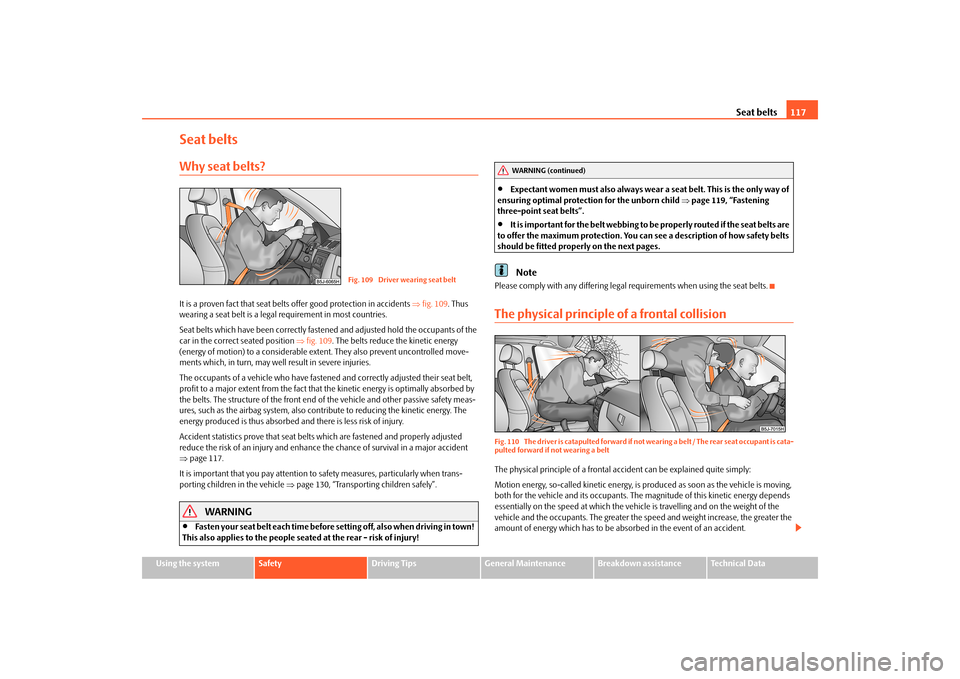
Seat belts
117
Using the system
Safety
Driving Tips
General Maintenance
Breakdown assistance
Technical Data
Seat beltsWhy seat belts?It is a proven fact that seat belt
s offer good protection in accidents
fig. 109
. Thus
wearing a seat belt is a legal requirement in most countries. Seat belts which have been correctly fasten
ed and adjusted hold the occupants of the
car in the correct seated position
fig. 109
. The belts reduce the kinetic energy
(energy of motion) to a considerable exte
nt. They also prevent uncontrolled move-
ments which, in turn, may well result in severe injuries. The occupants of a vehicle who have fastened
and correctly adjusted their seat belt,
profit to a major extent from the fact that
the kinetic energy is optimally absorbed by
the belts. The structure of the front end of the vehicle and other passive safety meas- ures, such as the airbag system, also cont
ribute to reducing the kinetic energy. The
energy produced is thus absorbed and there is less risk of injury. Accident statistics prove that seat belts which are fastened and properly adjusted reduce the risk of an injury and enhance the chance of survival in a major accident page 117. It is important that you pay attention to
safety measures, particularly when trans-
porting children in the vehicle
page 130, “Transporting children safely”.
WARNING
Fasten your seat belt each time before
setting off, also when driving in town!
This also applies to the people seated at the rear - risk of injury!
Expectant women must also always wear
a seat belt. This is the only way of
ensuring optimal protection for the unborn child
page 119, “Fastening
three-point seat belts”.
It is important for the belt webbing to be
properly routed if the seat belts are
to offer the maximum protection. You can see a description of how safety belts should be fitted properly on the next pages.
Note
Please comply with any differing legal requirements when using the seat belts.The physical principle of a frontal collisionFig. 110 The driver is catapulted forward if not
wearing a belt / The rear seat occupant is cata-
pulted forward if not wearing a beltThe physical principle of a frontal a
ccident can be explained quite simply:
Motion energy, so-called kinetic energy, is produced as soon as the vehicle is moving, both for the vehicle and its occupants. The
magnitude of this kinetic energy depends
essentially on the speed at which the vehicl
e is travelling and on the weight of the
vehicle and the occupants. The greater the speed and weight increase, the greater the amount of energy which has to be ab
sorbed in the event of an accident.
Fig. 109 Driver
wearing seat belt
WARNING (continued)
s3j8.a.book Page 117 Tuesday, April 20, 2010 1:10 PM
Page 120 of 244

Seat belts
119
Using the system
Safety
Driving Tips
General Maintenance
Breakdown assistance
Technical Data
How are seat belts correctly fastened?Fastening three-point seat belts Fasten your seat be
lt before starting!
Fig. 111 Routing of belt webbing over the sh
oulders and the lap belt / Routing of belt
webbing for an expectant mother– Correctly adjust the seat and the head restraint before fastening your seat belt
page 114, “Correct seated position”.
– Slowly pull the belt webbing at the tongue
of the lock over your chest and pelvis
.
– Insert the tongue of the lock into the seat belt buckle belonging to the seat until it
is heard to lock in place.
– Pull on the belt to check that it has also reliably engaged in the lock. Each three-point seat belt is equipped with
an inertia reel. This inertia reel offers you
complete freedom of movement if the belt is unreeled slowly. If the brakes are applied suddenly, the inertia reel will block. The
belts also block when the car accelerates,
when driving downhill and when cornering. Expectant mothers must also wear the seat belt
.
WARNING
The shoulder part of the seat belt must never run across your neck but must
run approximately over the middle of the shoulder and fit snugly against the
chest. The lap part of the belt must r
un across the hip and must never be routed
across the stomach. It must always fit snugly
fig. 111
- left. Adjust the belt
webbing as required.
The lap part of the belt should be posi
tioned as low as possible at the pelvis
of an expectant mother in order to avoid exerting any pressure on the lower abdomen
fig. 111
- right.
Always ensure that the webbing of the
seat belts is properly routed. Seat
belts which are not correctl
y adjusted can themselves cause injuries even in
minor accidents.
A seat belt which is hanging too loose can result in injuries as your body is
moved forward by the kinetic energy pr
oduced in an accident and is then
suddenly held firm by the belt.
Only insert the lock tongue into the lock which is the correct one for your
seat. This will affect the protection which
the belt offers and increase the risk of
an injury.Seat belt height adjuster on the front seatsThe seat belt height adjuster makes it possible for you to adapt the routing of the front three-point seat belt in the area of the shoulder to match your body size. – To adjust the belt height press the heig
ht adjuster and move it up or down
fig. 112
.
WARNING (continued)
Fig. 112 Front seat: Seat belt height adjuster
s3j8.a.book Page 119 Tuesday, April 20, 2010 1:10 PM